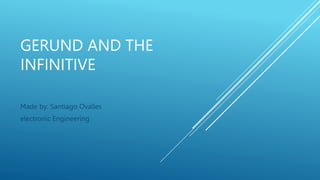GERUND AND THE INFINITIVE.pptx
•Télécharger en tant que PPTX, PDF•
0 j'aime•4 vues
tarea
Signaler
Partager
Signaler
Partager

Recommandé
Recommandé
Contenu connexe
Similaire à GERUND AND THE INFINITIVE.pptx
Similaire à GERUND AND THE INFINITIVE.pptx (20)
Ingles ipm verb to be, simples e present continuos

Ingles ipm verb to be, simples e present continuos
Dernier
Mehran University Newsletter is a Quarterly Publication from Public Relations OfficeMehran University Newsletter Vol-X, Issue-I, 2024

Mehran University Newsletter Vol-X, Issue-I, 2024Mehran University of Engineering & Technology, Jamshoro
Dernier (20)
General Principles of Intellectual Property: Concepts of Intellectual Proper...

General Principles of Intellectual Property: Concepts of Intellectual Proper...
Kodo Millet PPT made by Ghanshyam bairwa college of Agriculture kumher bhara...

Kodo Millet PPT made by Ghanshyam bairwa college of Agriculture kumher bhara...
Unit-V; Pricing (Pharma Marketing Management).pptx

Unit-V; Pricing (Pharma Marketing Management).pptx
Fostering Friendships - Enhancing Social Bonds in the Classroom

Fostering Friendships - Enhancing Social Bonds in the Classroom
Basic Civil Engineering first year Notes- Chapter 4 Building.pptx

Basic Civil Engineering first year Notes- Chapter 4 Building.pptx
On National Teacher Day, meet the 2024-25 Kenan Fellows

On National Teacher Day, meet the 2024-25 Kenan Fellows
This PowerPoint helps students to consider the concept of infinity.

This PowerPoint helps students to consider the concept of infinity.
Food safety_Challenges food safety laboratories_.pdf

Food safety_Challenges food safety laboratories_.pdf
GERUND AND THE INFINITIVE.pptx
- 1. GERUND AND THE INFINITIVE Made by: Santiago Ovalles electronic Engineering
- 2. INFINITIVE The infinitive is part of the basis for fully understanding the use of English verbs. The infinitive is the basic form of English verbs. It is usually structured as follows: to + (verb stem), for example, to talk. However, there is also the form without to. They are rarely used as the object of a preposition. Verb and expressions followed by infinitive are mental state or activity; agree, choose, decide, offer, etc. use as a noun: To know her is to love her Use as a verbal complement: I always wanted to have a dog Use as circumstantial: I had too many books to carry
- 3. GERUND A gerund is a non-finite (non-conjugated) form of the verb used to make a verb phrase that can replace a noun phrase. The present participle form is used because it ends in 'ing', e.g. 'hearing'. It’s generally followed by prepositions. Use as subject: Smoking is bad for your health. Use as an adjective: This is the waiting room, sir. Use as a verbal complement: Your hair needs cutting. Use as circumstantial: You can’t make an omelet without breaking some eggs. Use of structures with gerunds: Be used to indicate that something has become familiar. Use this expression when something is now a habit or routine By this time next year, I will be used to living in Brazil Get used to indicate that something is becoming familiar. Use this expression for a new habit or routine I am getting used to living with my new roommate
- 4. SEMANTIC DIFFERENCES IN THE USE OF THE GERUND AND INFINITIVE The gerund is more common when you are talking generally and the infinitive when you are talking about a specific occasion, example: • Gerund I like going to the dentist Infinitive • I like to go to the dentist once a year Gerunds are best for use in sentences about actions that are real or complete, or that have been completed. Infinitives are best for use in sentences about actions that are unreal or abstract, or that will occur in the future She stopped smoking years ago/ she stopped to smoke to tell you The first sentence refers to the fact that she stopped smoking a long time ago and does not plan to go back, in the second that she stopped smoking at that time to say something and then went back to smoking again. Therefore, when you want to speak in a specific way you use the infinitive and not the gerund.